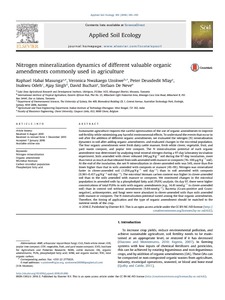Resource information
Sustainable agriculture requires the careful optimization of the use of organic amendments to improve soil fertility while minimizing any harmful environmental effects. To understand the events that occur in soil after the addition of different organic amendments, we evaluated the nitrogen (N) mineralization dynamics in soil after adding organic amendments, and evaluated changes in the microbial population. The four organic amendments were fresh dairy cattle manure, fresh white clover, vegetable, fruit, and yard waste compost, and poplar tree compost. The N mineralization potential of each organic amendment was determined by analyzing total mineral nitrogen during a 97-day laboratory incubation experiment. Soils amended with clover released 240 ?g N g?1 soil during the 97-day incubation, more than twice as much as that released from soils amended with manure or composts (76–100 ?g N g?1 soil). At the end of the incubation, the net N mineralization in clover-amended soils was 54%, more than five times higher than that in soils amended with composts or manure (4%–9%). Nitrogen was mineralized faster in clover-amended soil (1.056 ?g N g?1 soil day?1) than in soil amended with composts (0.361–0.417 ?g N g?1 soil day?1). The microbial biomass carbon content was higher in clover-amended soil than in the soils amended with manure or composts. We monitored changes in the microbial population in amended soils by a phospholipid fatty acid (PLFA) analysis. On day 97, there were higher concentrations of total PLFAs in soils with organic amendments (e.g., 14.41 nmol g?1 in clover-amended soil) than in control soil without amendments (9.84 nmol g?1). Bacteria (Gram-positive and Gram-negative), actinomycetes, and fungi were more abundant in clover-amended soils than soils amended with manure or composts. The N mineralization potential varied among the four organic amendments. Therefore, the timing of application and the type of organic amendment should be matched to the nutrient needs of the crop.


